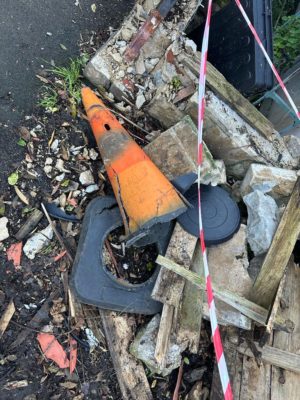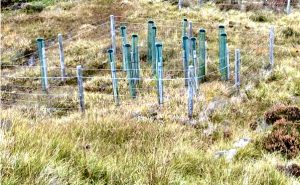Plastics and tree guards

Plastic is a problem, plastic is universal. A class from Ramsbury Primary School went on a walk round their village, looking for signs of plastic pollution. When they looked in the hedgerows (lining the paths and fields), they found old plastic tree guards (and hedge guards). Some were breaking up into pieces, some growing growing into the bark of the trees. In addition, there were plastic bottles, face masks, dog poo bags, sweet wrappers, plastic ropes, plastic bags, and plastic wrappers from hay bales.
Plastic litters our world. Each year, hundreds of million tonnes are produced. It is used but often it is not recycled - it is discarded. It litters the land, rivers and oceans. It is now almost impossible to walk in the countryside or on a beach without encountering plastic in one form or another. Discarded plastic can kill or injure. Mammals, reptiles, birds can be harmed through eating plastic or becoming entangled in it.
 Plastics are made up of repeating units (monomers) that join together to form long chains (polymers). There are six major polymer types, PET, HDPE, PVC, LDPE, PP and PS. Many are derived from petrochemicals. Additives are incorporated into plastics and these can gradually leach back out either during normal use, or when in landfills, or following improper disposal in the environment. Whilst plastics serve many different functions, their makeup means that they do not easily break down, they persist. Consequently, a lot of plastic goes to landfill or it may be burnt (to generate energy) - which in turn can release greenhouse gases and pollutants. Ideally plastics would be reused, like glass bottles were recycled in the dairy industry for over a century.
Plastics are made up of repeating units (monomers) that join together to form long chains (polymers). There are six major polymer types, PET, HDPE, PVC, LDPE, PP and PS. Many are derived from petrochemicals. Additives are incorporated into plastics and these can gradually leach back out either during normal use, or when in landfills, or following improper disposal in the environment. Whilst plastics serve many different functions, their makeup means that they do not easily break down, they persist. Consequently, a lot of plastic goes to landfill or it may be burnt (to generate energy) - which in turn can release greenhouse gases and pollutants. Ideally plastics would be reused, like glass bottles were recycled in the dairy industry for over a century.
Polyethylene is used widely for plastic bottles and food packaging, PVC is used to make pipes (for water / sewage), coating for electrical cables, uPVC windows and fascia boards. Recycled PVC can be used to make certain types of tree guards, for example :Spiral guards. Such guards offer protection to young trees and hedgerow so that they can establish themselves, avoiding being chomped by rabbits, deer or sheep. The guards also offer a micro-climate that helps growth. UV stabilised polyethylene is used to make netting / mesh to protect young trees.

Tree guards, to protect young trees on moorland
Tree failure can be an expensive process, so it is important to give young trees a ‘good start in life. A ‘weed’ free area around the planted tree reduces competition for water, light etc. In theory, it should be possible to reuse plastic guards, but they are often damaged, degraded or have to be cut to remove them from the young tree. As they are not biodegradable, it is important that they are collected and removed. Ideally this material should be recycled. If many trees are being planted, it may be simpler / more cost effective to fence off the planted area to protect young trees from browsing activity.
Because of the problems associated with plastic tree guards, there are now a number of alternatives available. For example, wool-based tree guards / shelters (eg. Next Gen) are fully biodegradable being made from
- wool
- A biodegradable polyol made from ethically sourced cashew nutshell liquid and castor oil
- A polymer that breaks down over time
Other biodegradable forms of tree protection make use of a polymer made from sugar cane (eg. HyTex products). Such guards decompose slowly through the action of microbes (bacteria and fungi), temperature and humidity, gradually forming a compost - so their removal is not needed.
Comments are closed for this post.

The alternatives to plastic described above are great to see. The problems created by plastic bottles very slowly breaking down, over decades, is not understood, as tree planting is becoming more and more significant, we need to be promoting the use of more sustainable materials – as highlighted. Well done for bringing this out in the article.
Brian Menzies
2 November, 2023